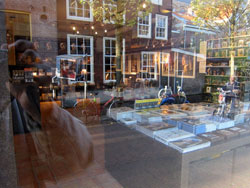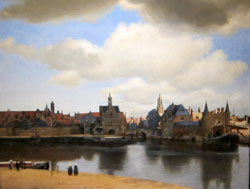Delft is delightful for walking and is an easy train ride from Amsterdam. The great Dutch painter Vermeer lived there, dying at age 43 in 1675. There are only 34 authenticated Vermeer paintings extant. All seven of Vermeer's remaining in the Netherlands are at the Rijks and the Mauritshuis ( see his 'Girl with Pearl Earring' on PD page 13).Vermeer's house/studio no longer exists and his only real presence, not including certain views of Delft, is the so-called Vermeer Museum, which is housed in the St. Lucas Gilde building. I was surprised that certain people on the streets either didn't know of him or his museum. Photo below left is my multi-image photo looking in the museum or, I would say, the Vermeer souvenir shop window....More on Vermeer: Vermeer's paintings are highly praised and noted for their almost photo-realistic quality. There has been much written regarding Vermeer's working methods. I want to reference and give links to three studies indicating the probability that Vermeer used optics to establish the realistic look to his paintings: The book by Philip Steadman "Vermeer's Camera: Uncovering the Truth behind the Masterpieces" in which he concludes that Vermeer used a camera obscura in producing his miraculous paintings. Here's an interview with Professor Steadman. Then, there is David Hockney's "Secret Knowledge: Rediscovering the Lost Techniques of the Old Masters" where he also concludes that optics were used by Vermeer as well as by many historical painters. Inventer Tim Jenison thru his ingenuity and curiousity became fascinated with Vermeer's ability to impart a realistic quality to his paintings and embarked on a mission utilizing optics (lenses and a mirror) to reproduce by painting Vermeer's "The Music Lesson" which he did. The film Tim's Vermeer documents his work and, for his purposes, confirmed his thinking that Vermeer used optics in painting his masterpieces....Below is my photo of Vermeer's masterpiece "View of Delft" (click on photo for enlarged view and then click again for details). Note the dabs of paint or Vermeer pointillés which populate each detail. These dabs give evidence to Vermeers knowledge in the use of a camera obscura in that such patterns are his means of reproducing reflected light such as produced by the camera obscura using the lenses of that day. More later on this subject but who cares of his methods; his painting are beautiful masterpieces...Now to my London trip report.

